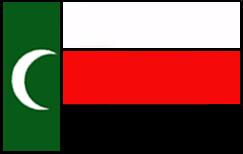| Library | Lane | Search Lane | Catalog |
| Contact Us | Web Site Accessibility |

| Don Macnaughtan | Lane Community
College Library Eugene, Oregon 97405 macnaughtand@lanecc.edu |

|
|
 2001 Don Macnaughtan
2001 Don MacnaughtanEthnographic Bibliographies no. 4
 The Meskhetian flag
The Meskhetian flag Who are the Meskhetians?
Who are the Meskhetians? What happened to the Meskhetians?
What happened to the Meskhetians? What is the current situation?
What is the current situation? A Meskhetian bibliography
A Meskhetian bibliographyThe flag of the Meskhetians
 The flag of the Meskhetian people is a horizontal tricolor of white, red and black, with a vertical green stripe on the hoist, charged with a white crescent moon. The crescent moon and green color are traditionally associated with Islam; the symbolism of the white/red/black tricolor is unclear.
The flag of the Meskhetian people is a horizontal tricolor of white, red and black, with a vertical green stripe on the hoist, charged with a white crescent moon. The crescent moon and green color are traditionally associated with Islam; the symbolism of the white/red/black tricolor is unclear.Who are the Meskhetians?
The Meskhetians are a dispersed people who are now scattered across the former Soviet Union, with the majority currently in Azerbaijan. The Meskhetians originally lived in the Meskhetian Range, a region in the south of the Republic of Georgia, along the Turkish border. Now numbering about 400,000, the Meskhetians are basically a Turkic people, but there are many linguistic and cultural influences from Georgians, Kurds, Ajars, Armenians, and "Franks" (Georgian Catholics).
There is some academic dispute about exactly who the Meskhetians are. Before the 1940s, the Meskhetians did not have a clear sense of ethnic identity themselves. They have evidently been in southern Georgia for centuries, and were either the result of immigration from Turkey, or Turkicization of the local population, or most likely a blend of both processes. Some of the few unifying factors were that the Meskhetians follow Islam (mainly Shia), and speak Oghuzic Turkish with many Laz Georgian elements.
However, in exile these peoples underwent a process known as "ethnogenesis", whereby a new national identity developed. Other peoples who were displaced by Stalinism developed in similar ways - the Chechens are a prime example. The current Meskhetian identity has formed over time from these disparate elements, and intensified under pressure in the last 50 years. The flag is one manifestation of this new identity.
What happened to the Meskhetians?
The Turkic peoples of the Meskhetian Range have had a long and sad history of conflict with neighboring Georgian, Russian, and Sunni Muslim peoples. Fierce repressions and violence broke out throughout the 19th and 20th centuries, culminating in Stalin's deportation of 115,000 Meskhetians in 1944 to the wastes of Central Asia, followed by 40,000 Meskhetian Red Army troops in 1945. The Meskhetians were deported to the last person - apparently none were left in Georgia. About 50,000 are thought to have died in this repression, from executions, starvation, cold and thirst. Many ended up in the Fergana Valley of Uzbekistan, in Kazakhstan, and in Kyrgyzstan, where they remained as refugees and outsiders.
Why were the Meskhetians deported? Nobody knows for sure. Stalin's secret police deported entire nationalities in this period, usually on charges of collaboration with the Germans. But the Meskhetians were hundreds of miles from the front lines, and thousands of Meskhetian soldiers were in the Red Army. There is some speculation that Stalin was clearing the ground for an invasion of Turkey. More likely, this tragedy was the product of some atavistic impulse within Stalin and Beria, the KGB chief. Both were Georgians, and seemed to harbor some deep antagonism towards the Islamic peoples of southern Russia - although they also deported the Buddhist Kalmyks.
Current situation
The KGB continued to restrict the Meskhetians until the early 1960s, but they were never allowed to return to southern Georgia. In 1989, as the Soviet Union began to unravel, hundreds of Meskhetians were killed or wounded in ethnic and religious pogroms in Uzbekistan. Currently, about 50,000 Meskhetians live in Azerbaijan, according to a report of the US Committee for Refugees. Some have returned to Georgia, where their return remains a delicate political issue. About 10,000 were invited to settle in Turkey by that country's government. There are many Meskhetian communities still scattered across Central Asia and Russia, where they continue to encounter residency problems and ethnic discrimination. Problems appear to be particularly intense in the Krasnodar region of Russia, where repressive measures are supported by local authorities, according to briefings from the European Conference Against Racism in October 2000.
Bibliography
 Alam, Shahed. "Right to Return of Ahiska Muslims." Muslim Weekly 2 Aug. 2004.
Alam, Shahed. "Right to Return of Ahiska Muslims." Muslim Weekly 2 Aug. 2004. Aslan, Kiyas. The Ahiska Turks. Ankara: Cultural and Solidarity Association of the Ahiska Turks, 1996. 80p.
Aslan, Kiyas. The Ahiska Turks. Ankara: Cultural and Solidarity Association of the Ahiska Turks, 1996. 80p. Balim, Cidgem. "Abstract: Language as a Tool of Group Survival." Pan-European Workshop on Minority Languages.
Balim, Cidgem. "Abstract: Language as a Tool of Group Survival." Pan-European Workshop on Minority Languages. Batalden, Stephen K. "The Farghona Valley Riots and Interethnic Conflict in Uzbekistan." The Newly Independent States of Eurasia. Phoenix: Oryx, 1993. 175-176.
Batalden, Stephen K. "The Farghona Valley Riots and Interethnic Conflict in Uzbekistan." The Newly Independent States of Eurasia. Phoenix: Oryx, 1993. 175-176. Blandy, George. "The Meskhetians: Turks or Georgians? A People Without a Homeland." Conflict Studies Research Centre.
Blandy, George. "The Meskhetians: Turks or Georgians? A People Without a Homeland." Conflict Studies Research Centre.
 Bogert, Carroll. "Russia's Ruined Lives: Ethnic Clashes and the Growing Refugee Problem." Newsweek 19 Mar. 1990: 30.
Bogert, Carroll. "Russia's Ruined Lives: Ethnic Clashes and the Growing Refugee Problem." Newsweek 19 Mar. 1990: 30.
 Cikovani, T'eimuraz. Mesxet'i Samsxe: Istoriul-et'nograpiuli Narkvevi. T'bilisi : Gamomcemloba sabcot'a sakart'velo, 1979 (in Georgian). 148p.
Cikovani, T'eimuraz. Mesxet'i Samsxe: Istoriul-et'nograpiuli Narkvevi. T'bilisi : Gamomcemloba sabcot'a sakart'velo, 1979 (in Georgian). 148p.
 Cutler, Robert M. "Javakhetia: Flashpoint or Bottleneck?" Report from the Open Society Institute Central Eurasia Project.
Cutler, Robert M. "Javakhetia: Flashpoint or Bottleneck?" Report from the Open Society Institute Central Eurasia Project.
 Dzadziev, Alexander, and Erik Batuev. "Multinational Russia." Moscow Times 16 May 2001.
Dzadziev, Alexander, and Erik Batuev. "Multinational Russia." Moscow Times 16 May 2001.
 "The Hague Meeting on Issues Relating to the Meskhetian Turks." OSCE High Commissioner on National Minorities.
"The Hague Meeting on Issues Relating to the Meskhetian Turks." OSCE High Commissioner on National Minorities.
 Kharatishvili, Levan. "Civil Involvement in Repatriation Process: The Issue of Deported Meskhetians." Minority Web Online Journal.
Kharatishvili, Levan. "Civil Involvement in Repatriation Process: The Issue of Deported Meskhetians." Minority Web Online Journal.
 Meskhetian Turks: Solutions and Human Security. New York: Open Society Institute, 1999. 72p.
Meskhetian Turks: Solutions and Human Security. New York: Open Society Institute, 1999. 72p.
 Meskhetian Turks (Georgians) Sites of Central Asia, Russia, Georgia, or Turkey. Virginia Tech University Libraries.
Meskhetian Turks (Georgians) Sites of Central Asia, Russia, Georgia, or Turkey. Virginia Tech University Libraries. "Meskhetians." MINELRES: Minority Electronic Resources.
"Meskhetians." MINELRES: Minority Electronic Resources.
 Minahan, James. "Meskhetians." Encyclopedia of the Stateless Nations: Ethnic and National Groups Around the World. Westport, CT: Greenwood Press, 2002. 1237-1242.
Minahan, James. "Meskhetians." Encyclopedia of the Stateless Nations: Ethnic and National Groups Around the World. Westport, CT: Greenwood Press, 2002. 1237-1242.
 Ossipov, Alexander. "The Main Trends in Self-Identification and Culture of the Akhalzikhe (Meskhetian) Turks." Diss. Institute of Ethnography, Russian Academy of Sciences, 1993 (in Russian).
Ossipov, Alexander. "The Main Trends in Self-Identification and Culture of the Akhalzikhe (Meskhetian) Turks." Diss. Institute of Ethnography, Russian Academy of Sciences, 1993 (in Russian).
 Ossipov, Alexander. "State Ideology's Influence on Minority Self-Consciousness and Activism: The Case of the Meskhetian Turks." Etnograficheskoye Obozreniye 2 1994: 35-40 (in Russian).
Ossipov, Alexander. "State Ideology's Influence on Minority Self-Consciousness and Activism: The Case of the Meskhetian Turks." Etnograficheskoye Obozreniye 2 1994: 35-40 (in Russian).
 Ossipov, Alexander, and O. Cherepova. Violation of the Rights of Forced Migrants and Ethnic Discrimination in the Krasnodar Territory: The Situation of Meskhetian Turks. Moscow: Memorial Books, 1996 (in Russian and English).
Ossipov, Alexander, and O. Cherepova. Violation of the Rights of Forced Migrants and Ethnic Discrimination in the Krasnodar Territory: The Situation of Meskhetian Turks. Moscow: Memorial Books, 1996 (in Russian and English).
 Panesh, Emma Kh., and L. B. Erlomov. "Meskhetians." Encyclopedia of World Cultures. Volume 6. Boston: GK Hall, 1994. 259-262.
Panesh, Emma Kh., and L. B. Erlomov. "Meskhetians." Encyclopedia of World Cultures. Volume 6. Boston: GK Hall, 1994. 259-262.
 Payin, Emil. "Population Transfer: Tragedy of the Meskhetian Turks." Cultural Survival Quarterly 16.1 (Winter 1992): 36-37.
Payin, Emil. "Population Transfer: Tragedy of the Meskhetian Turks." Cultural Survival Quarterly 16.1 (Winter 1992): 36-37.
 Peuch, Jean-Christophe. "Georgia: Meskhetians Search For Cultural Identity." Radio Free Europe/Radio Liberty Special Report 25 May 2001.
Peuch, Jean-Christophe. "Georgia: Meskhetians Search For Cultural Identity." Radio Free Europe/Radio Liberty Special Report 25 May 2001.
 Pohl, J. Otto. "Meskhetian Turks, Kurds and Khemshils." Ethnic Cleansing in the USSR, 1937-1949. Westport, CT: Greenwood Press, 1999. 129-136.
Pohl, J. Otto. "Meskhetian Turks, Kurds and Khemshils." Ethnic Cleansing in the USSR, 1937-1949. Westport, CT: Greenwood Press, 1999. 129-136.
 Ray, Kakoli. " Repatriation and De-territorialization: Meskhetian Turks' Conception of Home." Journal of Refugee Studies 13.4: 391-414.
Ray, Kakoli. " Repatriation and De-territorialization: Meskhetian Turks' Conception of Home." Journal of Refugee Studies 13.4: 391-414.
 Rubtsova, Yevgenia. "A People Without Residence Rights." Current Digest of the Post-Soviet Press Apr. 2001: 16-18.
Rubtsova, Yevgenia. "A People Without Residence Rights." Current Digest of the Post-Soviet Press Apr. 2001: 16-18.
 Sheehy, Ann, and Bohdan Nahaylo. The Crimean Tatars, Volga Germans and Meskhetians: Soviet Treatment of Some National Minorities. London: Minority Rights Group, 1980. 3d ed. 28p.
Sheehy, Ann, and Bohdan Nahaylo. The Crimean Tatars, Volga Germans and Meskhetians: Soviet Treatment of Some National Minorities. London: Minority Rights Group, 1980. 3d ed. 28p. Slackman, Michael. "One Family's Trail of Tears: Meskhetian Turks on the Run." Newsday 22 May 2000.
Slackman, Michael. "One Family's Trail of Tears: Meskhetian Turks on the Run." Newsday 22 May 2000.
 Soros Foundation Network. Krasnodar Meskhetian Turks. 1998.
Soros Foundation Network. Krasnodar Meskhetian Turks. 1998.
 Sumbadzehe, Nana "The Problem of Muslim Population of Southern Georgia: Prospects of Deportation and the Local Resistance."
Sumbadzehe, Nana "The Problem of Muslim Population of Southern Georgia: Prospects of Deportation and the Local Resistance." Sumbadzehe, Nana "Repatriation and Adaptation of Deported Meskhetians: Society and State in Supra-national Context."
Sumbadzehe, Nana "Repatriation and Adaptation of Deported Meskhetians: Society and State in Supra-national Context." Tucker, Elizabeth. "A Longing to Go Home." Time 12 Mar. 1990: 51.
Tucker, Elizabeth. "A Longing to Go Home." Time 12 Mar. 1990: 51.
 "Unwelcome in Krasnodar Territory, Meskhetian Turks Face Escalating Discrimination, Expulsion Efforts." Current Digest of the Post-Soviet Press Nov. 2001: 16.
"Unwelcome in Krasnodar Territory, Meskhetian Turks Face Escalating Discrimination, Expulsion Efforts." Current Digest of the Post-Soviet Press Nov. 2001: 16.
 Zeyrek, Yunus. Dunden bugune Ahiska Turklugu. Frankfurt: Turk Federasyon, 1994 (in Turkish). 179p.
Zeyrek, Yunus. Dunden bugune Ahiska Turklugu. Frankfurt: Turk Federasyon, 1994 (in Turkish). 179p.
| Lane Community College Library, Center
Building, 4000 East 30th Ave, Eugene, OR 97405 Questions or comments regarding this website can be directed to Don Macnaughtan. Email: macnaughtand@lanecc.edu. This page was last updated: 30 December, 2004 ©2004 Lane Community College |

